Punjab State Board PSEB 11th Class Biology Book Solutions Chapter 8 Cell: The Unit of Life Textbook Exercise Questions and Answers.
PSEB Solutions for Class 11 Biology Chapter 8 Cell: The Unit of Life
PSEB 11th Class Biology Guide Cell: The Unit of Life Textbook Questions and Answers
Question 1.
Which of the following is not correct?
(a) Robert Brown discovered the cell.
(b) Schleiden and Schwann formulated the cell theory.
(c) Virchow explained that cells are formed from pre-existing cells
(d) A unicellular organism carries out its life activities within a single cell.
Answer:
(a) Robert Brown discovered the cell.
Question 2.
New cells generate from
(a) bacterial fermentation
(b) regeneration of old cells
(c) pre-existing cells
(d) abiotic materials
Answer:
(c) New cells generate from pre-existing cells.
![]()
Question 3.
Match the following:
| Column I | Column II |
| (a) Cristae | (i) Flat membranous sacs in stroma |
| (b) Cisternae | (ii) Infoldings in mitochondria |
| (c) Thylakoids | (iii) Disc-shaped sacs in Golgi apparatus |
Answer:
| Column I | Column II |
| (a) Cristae | (ii) Infoldings in mitochondria |
| (b) Cisternae | (iii) Disc-shaped sacs in Golgi apparatus |
| (c) Thylakoids | (i) Flat membranous sacs in stroma |
Question 4.
Which of the following is correct?
(a) Cells of all living organisms have a nucleus
(b) Both animal and plant cells have a well defined cell wall
(c) In prokaryotes, there are no membrane bound organelles
(d) Cells are formed de novo from abiotic materials
Answer:
(a) Cells of all living organisms have a nucleus.
Question 5.
What is a mesosome in a prokaryotic cell? Mention the functions that it performs.
Answer:
Mesosome is a special membrane structure which is formed by the extension of the plasma membrane into the cell in a prokaryotic cell. It helps in cell wall formation, DNA replication and distribution to daughter cells. It also helps in respiration, secretion possesses to increase the surface area of the plasma membrane and enzymatic content.
Question 6.
How do neutral solutes move across the plasma membrane? Can the polar molecules also move across it in the same way? If not, then how are these transported across the membrane?
Answer:
Neutral solutes may move across the membrane by the process of simple diffusion along the concentration gradient. The polar molecules cannot pass through tha non-polar lipid bilayer, they require a carrier protein to facilitate their transport across the membrane. A few ions or molecules are transported across the membrane against their concentration gradient i. e., from lower to the higher concentration. Such a transport is an energy dependent process in which ATP is utilised and is called active transport, e.g., Na+/K+ pump.
![]()
Question 7.
Name two cell organelles that are double membrane bound. What are the characteristics of these two organelles? State their functions and draw labelled diagrams of both.
Answer:
Chloroplasts and mitochondria are double membrane bound organelles.
Characteristics of Mitochondria
(i) The mitochondria are sausage-shaped or cylindrical having a diameter of 0.2-1.0 pm and average 0.5 pm and length 1.0-4.1 μm.
(ii) Each mitochondrion is a double membrane bound structure.
(iii) The inner compartment is called the matrix. The outer membrane of mitochondria forms the continuous limiting boundary of the organelle.
(iv) The inner membrane forms a number of infoldings called the cristae (single crista) towards the matrix. The cristae increase the surface area.
(v) The two membranes have their own specific enzymes associated with the mitochondrial function. The matrix of mitochondria also possess single circular DNA molecule, a few RNA molecules, ribosomes (70 s) and the components required for the synthesis of proteins.
Functions of Mitochondira: Mitochondria are the sites of aerobic respiration. They produce cellular energy in the form of ATP hence they are known as power house of the cell.
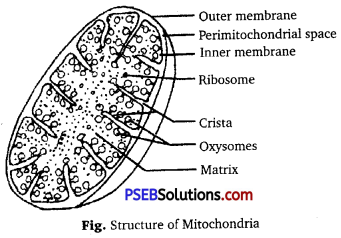
Characteristics of Chloroplasts
- The chloroplasts are also double membrane bound organelles.
- The space limited by the inner membrane of the chloroplast is called the stroma.
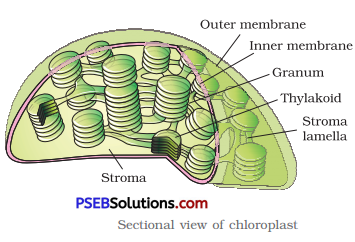
- A number of organised flattened membranous sacs called the thylakoid are present in the stroma.
- Thylakoids are arranged in stacks-like the piles of coins called grana.
- In addition there are flat membranous tubules called the stroma lamellae connecting the thylakoids of the different grana.
- The stroma of the thylakoids enclose a space called a lumen.
- The stroma of the chloroplast contains enzymes required for the synthesis of carbohydrates and proteins.
- Chlorophyll pigments are present in the thylakoids.
- The ribosomes of the chloroplants are smaller (70S) than the cytoplasmic ribosomes (80S).
Functions of chloroplasts: The chloroplasts contain chlorophyll and carotenoid pigments which are responsible for trapping light energy essential for photosynthesis.
Question 8.
What are the characteristics of prokaryotic cells?
Answer:
Characteristics of Prokaryotic Cells
- A prokaryotic cell, i.e., of bacteria is surrounded by a cell membrane. The cell wall in turn is surrounded by a slimy layer.
- Absence of well organised chloroplast, mitochondria and nucleus.
- The true nucleus with nuclear membrane, nucleolus is absent. It is known as nucleoid. The DNA of a prokaryotic cell is circular and not associated with basic proteins.
- The cytoplasm is filled with dense granules. Most of these granules are ribosomes.
- In chloroplast the scattered thylakoids are present. They are not organised in the form of stacks.
![]()
Question 9.
Multicellular organisms have division of labour. Explain.
Answer:
The body of a multicellular organism has cell as a basic structural unit. The cells organised to form tissues such as blood, bone, etc. The tissues organised to form organs such as heart, kidney, etc. The organs then organised to form organ systems such as digestive system, reproductive system and respiratory system, etc. The various organ systems of organism get arranged to form a complete individual.
Question 10.
Cell is the basic unit of life. Discuss in brief.
Answer:
All organisms begin their life in a single cell. Certain organisms complete their life cycle as a single cell. They are called unicellular or acellular organisms, e.g., Amoeba, Chlamydomonas, bacteria and yeast. In other organisms, the, single cell undergoes divisions to form multicellular body. Body of human being, is made up of trillion of cells. All the cells of an organism carry the same genetic material, develop from same pre-existing cells and possess several organelles to perform various life activities. The cells are therefore, basic unit of life and structural unit of an organism.
Question 11.
What are nuclear pores? State their function.
Answer:
Nuclear pores are. small apertures present in the nuclear membrane.
Functions of Nuclear Pores: Nuclear pores are highly selective in their permeation. They allow outward passage of newly formed ribosome units but prevent the entry of active ribosomes. Proteins synthesised in the cytoplasm enter the nuclear through nuclear pores but ions like K+ Na+ or Cl– may not be able to gain entrance.
Question 12.
Both lysosomes and vacuoles are endomembrane structures, yet they differ in terms of their functions. Comment.
Answer:
Both lysosomes and vacuoles are covered by a single membrane. Both of them perform different types of functions. Lysosomes contain hydrolysing enzymes and can hydrolyse all types of organic substances, – except cellulose. They perform phagocytic function. Therefore, they are known as suicidal bags.
The vacuoles are non-cytoplasmic sacs which, are also covered by a membrane. The sap vacuoles store sap or water with dissolved organic and inorganic substances. They maintain osmotic pressure or turgidity. Some freshwater invertebrates such as Amoeba, Paramecium occur contractile vacuoles, which perform osmoregulation and excretion. There is another type of vacuoles such as food vacuole which store food and gas vacuoles which store metabolic gases and take part in buoyancy regulation.
Thus, both lysosomes and vacuoles differ from each other in the type of functions they perform.
![]()
Question 13.
Describe the structure of the following with the help of labelled diagrams:
(i) Nucleus
(ii) Centrosome
Answer:
(i) Nucleus: It is a double membrane bounded protoplasmic body that carries hereditary information. Chemically it contains DNA, basic proteins, non-basic proteins, RNA, lipids and minerals, etc.
(a) Nuclear envelope: It is made up of two nuclear membranes separated by 10-70 nm perinuclear space. The outer membrane is rough due to the presence of ribosomes. Nuclear envelope has many pores with diameter
200-800 Å.
(b) Nucleoplasm or nuclear matrix: It is a colloidal complex that fills the nucleus. Nucleoplasm contains raw material for synthesis of DNA and RNA
(c) Chromatin: It is a fibrous hereditary material formed by DNA-histone complex. Some non-histone proteins and also RNA.- A single human cell has about 2 metre long thread of DNA distributed among its 46 chromosomes.
(d) Nucleolus: It was originally discovered by Fontana (1781) and given the present name by Bowman (1840). It is naked roughly rounded darkly stained structure that ‘ is attached to chromatin at specific spot called Nucleolar Organiser Region (NOR). Nucleolus is the site for eLaboration of rRNA and synthesis of ribosomes. It is therefore, known as ribosomal factory.
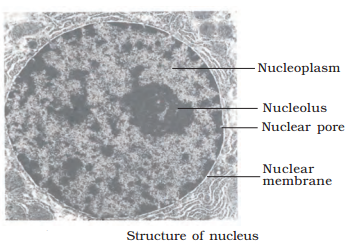
Centrosome: It is an organelle usually containing two cylindrical structure called centrioles. They are surrounded by amorphous pericentriolar materials. Both the centrioles in a centrosome lie perpendicular to each other in which
each his an organisation like the cartwheel.
They are made up of nine evenly spaced peripheral fibrils of tubulin protein the central part of the proximal region of centriole is called hub, which is connected with tubules of the peripheral triplet by radial spokes made of protein. The centriole form the basal bodies of cilia or flagella and spindle fibres that give rise to spindle apparatus during cell division in animal life.
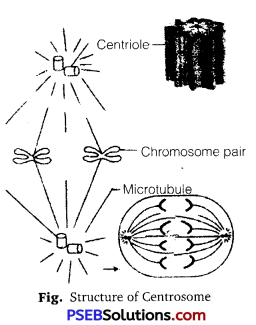
![]()
Question 14.
What is a centromere? How does the position of the centromere form the basis of classification of chromosomes? Support your answer with a diagram showing the position of centromere on different types of chromosomes.
Answer:
Centromere is a narrow non-stainable area, which join two similar threads or chromatids of a late prophase or metaphase chromosome. The two parts of the chromosome on either side of the centromere are known as arm. They may be isobranchial (equal) or heterobranchial (unequal in length). Depending upon the position of the centromere, the chromosomes are classified as follows:
- Acrocentric Chromosome: The centromere is sub-terminal, at anaphasic stage appear J-shaped.
- Sub-metacentric Chromosome: The centromere is sub-median and the anaphasic chromosome appear L-shaped.
- Metacentric Chromosome: The centromere is in the middle and the chromosome appears V-shaped in anaphase.
- Telocentric Chromosome: Centromere is terminal, anaphasic stage is I-shaped.
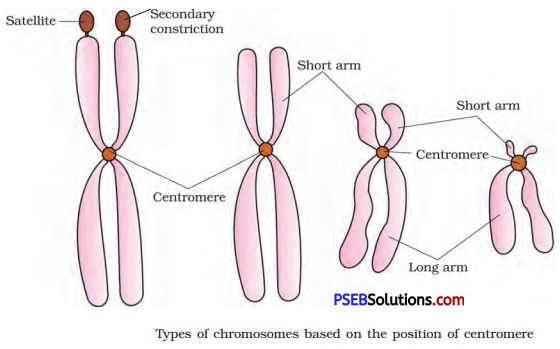
Depending upon the number of centromeres a chromosome possess, it may be monocentric, dicentric (two centromeres), polycentric (many centromeres), acentric chromosome (having no centromere).
